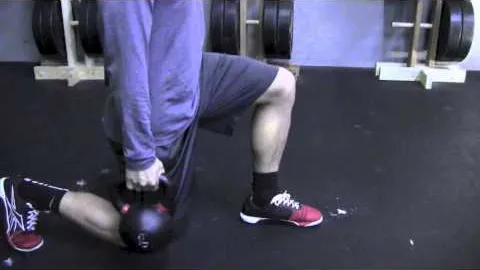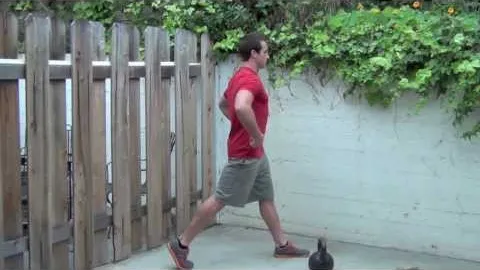



Leg training is an essential component of any well-rounded fitness routine. It helps build strength, stability, and mobility in the lower body, while also enhancing overall athletic performance. One exercise that effectively targets the leg muscles and improves functional movement is the kettlebell lunge.
The kettlebell lunge is a compound exercise that primarily targets the quadriceps, hamstrings, and glutes, while also engaging the calf muscles and core. It is a dynamic movement that requires coordination, balance, and control throughout the entire range of motion.
Starting Position: Begin by standing up straight with your feet about hip-width apart. Hold a kettlebell in one hand, either by the handle or by the horns (sides), close to your chest.
Step Forward: Take a big step forward with one foot, keeping your torso upright and core engaged. Your front knee should be directly above your ankle, forming a 90-degree angle, while the back knee should be hovering just above the ground.
Drive Through the Heel: Push through your front heel to extend your knee and hip, bringing your back foot back to the starting position. Ensure that your weight is evenly distributed through both feet.
Alternate Legs: Repeat the same movement with the opposite leg, stepping forward and lunging down. Continue alternating legs for the desired number of repetitions.
The kettlebell lunge offers numerous benefits for individuals at all fitness levels. Here are some key advantages of incorporating this exercise into your leg training routine:
The kettlebell lunge is a compound movement that targets multiple muscle groups simultaneously. It builds strength in the quadriceps, hamstrings, and glutes, helping to improve overall lower body stability and power.
Functional movements mimic activities of daily living and sports-specific motions. The kettlebell lunge aids in developing stability, balance, and coordination, which are crucial for performing functional movements efficiently.
During kettlebell lunges, the core muscles are engaged to maintain proper balance and control. This exercise promotes core stability and strengthens the abdominal muscles, aiding in overall posture and injury prevention.
Executing kettlebell lunges requires a good range of motion in the hip flexors and quadriceps. Regular practice can help improve flexibility in these areas, reducing the risk of muscle imbalances and enhancing overall mobility.
Kettlebell lunges can be performed in a high-intensity circuit or as part of an aerobic workout routine. Incorporating this exercise into a cardiovascular program helps improve endurance and burn calories, making it an effective addition to a weight loss program.
To further challenge your leg muscles and add variety to your workouts, you can try different variations of kettlebell lunges:
Instead of stepping forward, step backward when performing the lunge. This variation puts more emphasis on the glutes and hamstrings.
Performing walking lunges involves taking a step forward with each leg, alternating as you move across a designated space. This variation increases cardiovascular demand and can be a great way to improve balance and coordination.
Hold a kettlebell by the horns close to your chest, allowing the weight to rest on your upper body. This variation adds extra resistance to the movement and targets the quadriceps and glutes.
While kettlebell lunges are generally safe when performed correctly, it is essential to consider the following tips to avoid injury and maximize the benefits:
Start with a light kettlebell weight and gradually increase it as you become comfortable with the exercise. Proper form and technique take precedence over heavy weights.
Maintain an upright torso throughout the movement to avoid placing excessive strain on the lower back.
Keep your front knee aligned with your toes to prevent excessive stress on the knee joint.
Engage your core muscles to stabilize your spine and maintain balance.
If you have any pre-existing knee or hip conditions, it is advisable to consult with a healthcare professional before including kettlebell lunges in your workout routine.
The kettlebell lunge is an effective exercise for strengthening and toning the lower body while improving functional movement. With proper form and technique, this compound movement targets the quadriceps, hamstrings, glutes, and core muscles simultaneously. By incorporating variations and following safety tips, you can enhance your leg training routine and achieve optimal results. Challenge yourself, but always prioritize proper form, and gradually increase the intensity and weight as your fitness level progresses. So, lace up your sneakers, grab a kettlebell, and start lunging your way to stronger, more powerful legs!
If you're looking for a gym, fitness club or yoga studio, you've come to the right place.
You can find information about gyms in your area. Browse catalog of gyms and find gyms with classes which are you looking for.
On gym page you can find simple information like address, phone or website. You can find list of available classes. You can check availability of personal training or small group classes. On place page you can also see information about open hours.
You can find gyms near you with amenities, courts, studios and equipments.
Use our map to find gym at your city or district.
In Gym Navigator you can find list of exercises with movies for many body parts.
You can browse exercises catalog and find exercises the best of you.
You can also find exercises grouped into workout plans, which you can use to improve you body. Each routine show you exercises one by one and give you possibility to count you progress and count down rest time.